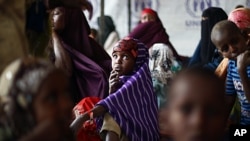Current and former U.S. representatives at the United Nations Food and Agriculture agencies Saturday wrapped up their three-day visit to Kenya to assess the international response to the Horn of Africa's ongoing drought and famine. They said aid agencies are able to access more areas in southern Somalia and that aid is reaching people in need, but more must be done.
The World Food Program's regional director, Stanlake Samkange, told reporters in Nairobi his agency is expanding food distributions in Mogadishu.
The agency can now operate directly in the Gedo region as well as in other pockets north and south of the Somali capital that were previously sealed off by the al-Qaida-linked militant group al-Shabab.
"The access situation is changing in southern Somalia, I think because of the pressure and the serious condition there, and we are responding to that very actively and very aggressively," said Samkange.
But, he says, Mogadishu is still dangerous because of what he calls a "security vacuum" that was created following al-Shabab's recent withdrawal from there.
"Unfortunately, at a distribution a little over a week ago, after 70 percent of the distribution had passed peacefully, there was a disturbance amongst the security elements providing security there, and a number of people lost their lives and there was looting of some quantities of food," added Samkange.
Samkange was part of a U.S.-led delegation visiting the Kenyan capital and the Dadaab refugee camp near the Kenyan-Somali border earlier in the week. The aim of the three-day visit was to assess the effectiveness of international efforts to deal with drought and famine in the Horn of Africa.
Samkange said that, in the month of July, more Somali refugees showed up at Dadaab than in any other month in the camp's 20-year history, creating in his words, an "unprecedented challenge." Dadaab was meant to house 90,000 people, but the population now stands at 440,000 and rising.
He said aid workers have had to be flexible and innovative in dealing with the crisis.
Ertharin Cousin, the current U.S. representative at the United Nations Food and Agriculture agencies, said discussions with the Kenyan government to expand the Dadaab refugee camp were successful, with the government giving the United Nations' refugee agency permission to open the Ifo II camp, which can accommodate up to 40,000 people.
Cousin lauded efforts by aid agencies to deliver food and other supplies to people desperately in need, at Dadaab refugee camp and elsewhere.
"I talked to someone yesterday, a mother and father with four young children, who had walked for 17 days to come from their home to the camp. We were looking at two young boys who literally were skin and bones. But these were parents trying to save their children. When they arrived at the camp, the assistance was there," noted Cousin.
Cousin reported that $1 billion has been pledged and raised to date by the international community, but the United Nations says it needs an additional $1.5 billion to assist drought and famine victims across the Horn of Africa until the rains come, usually in October.
The World Food Program's Samkange says normally his agency aims to have enough food and supplies in stock to cover three months, but at the moment they are operating on a month-by-month basis.
He urged donors to continue giving support to drought and famine efforts.
"We still need to be sure that in two or three or four months' time we don't find ourselves back in the situation of having to reduce support to people because the international community may have looked elsewhere," Samkange said.
The drought ravaging the Horn of Africa is said to be the worst in decades, with more than 12 million people facing hunger and starvation. Exacerbating the situation in Somalia is conflict between the militant Islamic group al-Shabab and the transitional government, which has caused many parts of the south to be closed to relief work until recently. The United Nations recently declared several regions there as being famine zones.
More Food Aid Needed in E. Africa











